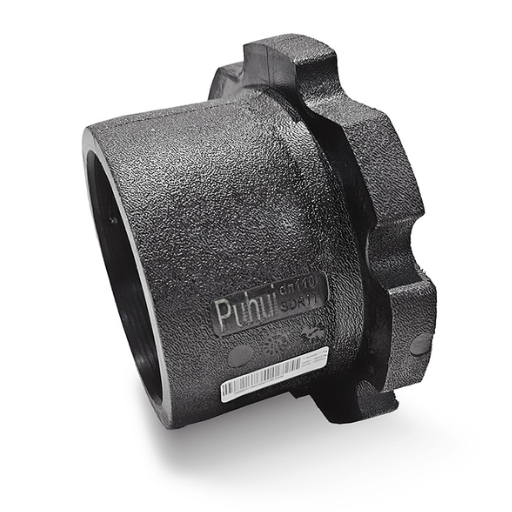In this vital guide, we will look at the setting up of electrofusion flanges, an essential component in high-density polyethylene (HDPE) fittings. Professionals in the sector should understand the complexities of electrofusion flanges because HDPE piping systems are increasingly being relied upon for their durability and resistance to corrosion. This piece will explain how to install it, the tools required, and valuable hints that can ensure a solid and efficient connection. By the end of this article, one will have gathered enough knowledge on effective working with electrode fusion flanges, thus enhancing his or her expertise in HDPE fitting applications.
What is an Electrofusion Flange, and How Does It Work?
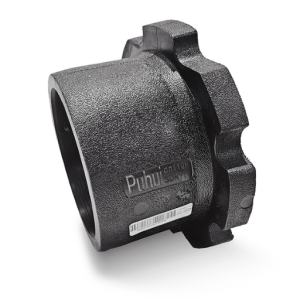
Image source: https://www.phhdpepipe.com/
An electrofusion flange is used to securely join HDPE pipes and other HDPE components together. It comprises a flange made usually from HDPE containing built-in electric heaters. This fusion process involves passing an electric current through these elements, causing them to heat up so much that they melt and combine at the joint with the rest of the HDPE material, forming one substance. In return, a solid tight-fit connection that cannot allow any environmental factors to affect it is produced, making it ideal for different types of pipe works. The simplicity and effectiveness of this method have seen it being widely applied in infrastructure like water and gas distribution systems, among others.
Understanding HDPE Electrofusion Fittings
HDPE electrofusion fittings are essential parts that help to make seamless connections within HDPE pipes. These fittings have inbuilt heating elements that promote fusion when an electric current is passed. The heat generated softens and fuses the HDPE material, thus forming a bond that is strong enough and resistant to environmental stresses. It is among the technologies that reduce the chances of leakages and increase their adaptability towards multiple applications such as water, gas, and wastewater management. Their simplicity and reliability have made them a favorite for many engineers and contractors in both the construction and utilities sectors.
The Role of Flange in HDPE Pipe Systems
Flanges are crucial in HDPE pipe systems since they secure different pipeline components and maintain their stability. They are easy to assemble or dismantle, easing the process of maintenance or inspection of the entire pipe network. Additionally, flanges improve the strength of these joints, allowing them to withstand operational pressures and environmental circumstances throughout the system. Moreover, HDPE flange designs consider thermal expansion and contraction necessary for retaining its performance over time. By incorporating this with electro-fusion flanges, they can achieve a reliable connection without any leaks that is suitable for efficient transmission of fluids in various settings, including municipalities and industries.
Components of an Electrofusion Flange Assembly
An electrofusion flange assembly comprises several vital components that work together to form a reliable joint in HDPE piping systems. These include:
- Electrofusion Flange: This acts as the body of the assembly, with heating elements inside that facilitate fusion. It is designed to be aligned with the HDPE pipe ends for proper fitting.
- HDPE Pipe: The pipes serve as channels for various fluids, such as water, gases, and other materials, and their durability and performance increase when they are seamlessly integrated with electrofusion flanges.
- Backing Ring: This ring sits between the flange and the pipe, providing additional mechanical strength and stability to the connection.
- Fusion Elements: These resistive heating elements are situated within the flange. They create heat upon passing an electric current through them, causing HDPE material to melt and forming strong bonds.
- Alignment Pins (optional): These pins help maintain proper alignment during assembly by ensuring the flange is placed at one end of a pipe before electrofusion begins.
By combining these components, an electrofusion flange assembly can provide a strong, secure connection that is free from leaks, making it possible to serve various applications common in municipalities or industries.
How to Shop by Price for Electrofusion Flanges
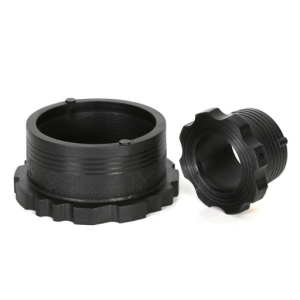
To purchase electrofusion flanges, begin by determining your financial capabilities so as to know the price range of different types in stores. When comparing prices from various suppliers, consider the quality of the material used, the size of the flanges, and other features like alignment pins. Another advantage may be bulk buying, where many suppliers offer return discounts for huge orders. Lastly, go through ratings given by customers who have bought such items earlier and read the specifications provided by manufacturers about their products so that you get high-quality parts suitable for your specific need since sometimes; cheapness could turn out expensive eventually.
Factors Influencing the Cost of Electrofusion Fittings
Some key points worth noting when evaluating electrofusion fitting expenses are:
- Material Quality: The type and grade of the materials used significantly affect pricing. However, HDPE (high-density polyethylene) materials have better temperature and pressure resistance and often cost more but last longer.
- Size and Specification: The size of the fitting, including diameter and pressure rating, determines its price. Larger or specialized fittings designed for specific applications are often more expensive because of the complexity involved in their manufacture.
- Manufacturer And Brand Reputation: Some well-established brands will always be associated with quality, hence charging higher prices. In contrast, others can charge less since they are still new industry players. Customers might be willing to pay more just because they want items supplied by reputable manufacturers known for producing good ones that work efficiently in harsh conditions.
- Supply Chain Factors: Price fluctuations, the availability of raw materials, shipping costs, and market demand can cause price variations. Economic factors are likely to impact how much those supplying electrofusion fittings should ask for.
These considerations help buyers understand the cost dynamics of electrofusion fittings and make better purchase decisions.
Finding Quality HDPE Fittings at Competitive Prices
To locate suppliers of quality HDPE fittings at competitive prices, it is advisable to consider trusted online vendors offering a wide range of products.
- Grainger: Offers an extensive range of HDPE fittings and includes electrofusion options; prices are very competitive, with discounts for bulk purchases. The site has user reviews that help customers gauge the quality and usability of each fitting.
- McMaster-Carr: Is known for its vast inventory and fast shipping; there, one can find various HDPE fittings along with technical specs and availability. Their layout allows for easy comparison between similar products.
- U.S. Plastic Corp: A company specializing in plastic products, U.S. Plastic Corp carries numerous types of HDPE fittings. They usually have good prices and sales promotions, so your purchases will be within budget limits.
By comparing prices and product offerings, buyers can make educated decisions to find the best quality HDPE fittings for their specific needs.
How do I manage my account for electrofusion fittings purchases?
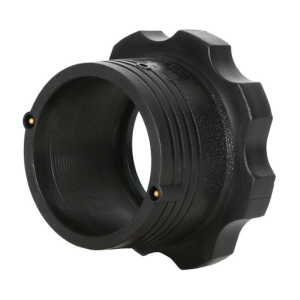
You must manage your account for purchasing electrofusion fittings to streamline the buying process and maintain your order history. Start by logging into your account on the supplier’s website. From here, you may update personal details such as shipping or billing addresses and payment methods to enable smooth transactions. Keeping track of previous orders helps reorder or reference past purchases by monitoring purchase history. Also, take advantage of any notification settings to receive updates on product availability, promotions, or discounts if applicable to you at any point during which the latter opportunity is provided it. Finally, periodically review your account for subscription settings or wish lists to refine future buying decisions according to what is ordered before a supply contract is given out again between them themselves anymore, where any subscription settings would require you to renew some wishlists either way, thus having still not deleted their wish lists at least once more.
Creating and Managing Your Account
To purchase electrofusion fittings and create an account for management, do the following:
- Account Registration: Open the relevant website (McMaster-Carr, U.S. Plastic Corp., or any other respectable distributor). You will find a “Sign Up” or “Create Account” button at the top right corner of most pages. Type your name, email address, and password in the spaces provided. Sometimes, you may be asked to provide more information for verification purposes.
- Updating Your Account Information: When logged in, go to your account settings or profile area. This is where you can change shipping and billing addresses, add new credit cards, and adjust any personalization options that can improve your shopping experience.
- Order Management: To trace your purchases, look for Order History or Orders on some sites under My Account, as shown below. This allows you to review previous transactions, reorder familiar items quickly, and refer back to old buys when necessary.
- Notifications and Subscriptions: Modify notification preferences that inform about product availability announcements or special offers/discounts. If there is a wishlist feature or subscription service on their site, use them appropriately to expedite future buying decisions.
If these steps are followed accurately, one can quickly establish an account that will enable him/her to manage the purchasing of electrofusion fittings from major suppliers conveniently while improving his/her shopping experience with them.
Tracking Orders of HDPE Electrofusion Fittings
To follow your HDPE electrofusion fittings orders to different suppliers, it is easy for each site:
- McMaster-Carr: This procedure entails signing into your account and proceeding to the “My Account” section. From here, click on “order history” to view previous orders. Each order typically has a tracking link or can be tracked by status updates that give information about the shipment.
- U.S. Plastic Corp: Once you are logged in, simply go to “Account” and click on “Order Status.” This will provide details on all orders made, including the shipping details and current shipments’ tracking numbers.
- Other Reputable Suppliers: While with them, you may log into your account, where you would find something like“Orders” or “Track Orders.” There is an option of following any respected supplier’s tracking link next to every order he/she has until it is brought to delivery.
These sections on these websites enable you to monitor your electrofusion fitting orders and receive updates about the progress of their shipping.
Account and Billing Inquiries for Electrofusion Components
Understanding the rules of these top-selling firms is crucial for handling questions related to bills and managing your account for electrofusion parts.
- McMaster-Carr: This customer service page provides detailed information about managing accounts and billing issues, as well as how to change payment methods. For specific inquiries, one should contact their support team either through email or phone if one needs prompt responses.
- U.S. Plastic Corp: They have an FAQ segment that responds to common questions regarding what users might be going through with their accounts, such as how to change billing addresses and process refunds easily. Additionally, they would love it if customers could use live chat when immediate replies are needed or get hold of them through telephone calls.
- Ferguson: Ferguson’s website has dedicated a customer support section that provides steps on handling billing requests, getting invoices, and making online payments. People using their accounts are advised to log in to manage billing details and acquire adequate information about how they are billed.
These websites can help you find solutions for all questions concerning accounts or payments made when buying electrofusion components.
Who Are the Current Top Sellers of Electrofusion Couplers and Flanges?
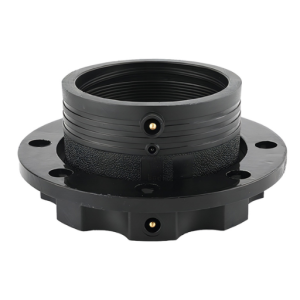
Some industry leaders that emerge for their quality products and exceptional service when in search of reliable suppliers of electrofusion couplers and flanges are highlighted below:
- McMaster-Carr: McMaster-Carr is known for its vast stock, fast shipping options, and detailed product information on various electro-fusion couplers and flanges.
- Ferguson: Ferguson offers a wide variety of electrofusion fittings at competitive prices. An informed sales team can guide customers on appropriate choices based on their requirements.
- U.S. Plastic Corp: The buyer-oriented approach keeps U.S. Plastic Corp ahead of its competitors, offering extensive stocks, including couplers and flanges, at reasonable costs.
These companies are some of the top providers of electrofusion fittings because they offer quality products and excellent customer service.
Leading Manufacturers of HDPE Electrofusion Couplers
- Garnet Equipment: Garnet Equipment is among the companies that design high-quality HDPE Electrofusion Couplers, which has made it one of the most innovative players in this field that adheres to industry standards; they have been widely accepted for industrial usage, hence portraying trustworthiness as well as durability assurance.
- Georg Fischer: Georg Fischer is a global manufacturer of piping systems, producing various types. They place special emphasis on quality HDPE materials when making electro-fusion joints. They have become popular due to their excellent production brands and broad product range, which serve professionals’ needs better than others.
- Fusion Group: Fusion Group is a manufacturer specializing in electrofusion systems, offering a range of HDPE couplings designed to enable optimal performance. To satisfy clients’ needs through technology enhancement, thus guaranteeing that its products surpass all excellence expectations.
These manufacturers are global leaders in HDPE electrofusion fittings due to their quality products and outstanding customer focus on innovations.
Top Brands Offering High-Quality Flange Adapters
- Victaulic: Victaulic is the best-known mechanical pipe joining systems manufacturer in the world. It offers a wide range of flange adapters that last longer and are easy to install. These products can be found in many industrial sectors, including plumbing, HVAC, and fire protection.
- Datwyler: This producer specializes in high-performance flange adapters that improve sealing efficiency and prevent leakage. Their solutions are widely approved for critical applications, ensuring safety and reliability across different industries.
- Eisele: Eisele supplies various types of specially designed high-performance flange adapters. Manufactured with accuracy and quality materials, these items have become favorites among those who use them for industrial purposes.
These brands have market acceptance due to their dedication to improving quality and innovating flange adapter solutions.
Customer Reviews and Ratings of Electrofusion Flanges
On the other hand, A few notable things regarding customer reviews and ratings of electrofusion flanges. Many users talk about how efficient these fittings are, mentioning their durability and ease of securing them compared to other system components. In addition, Amazon Reviews show excellent customer satisfaction rates, consistently above four stars, where customers appreciate quick installation procedures plus solid construction that such companies as Victaulic or Eisele provide, among others. Lastly, Thomasnet publishes testimonials pointing out why product quality matters, especially in high-pressure applications; thus, many enterprises claim that well-engineered electrofusion flanges contributed towards successful project outcomes within numerous spheres of industry. As a result, all these reviews show unanimity over electrofusion flanges’ efficiency and firmness, thereby being reputable tools for well-established applications.
What Products Have Been Selected for Comparison in the Electrofusion Fittings Market?
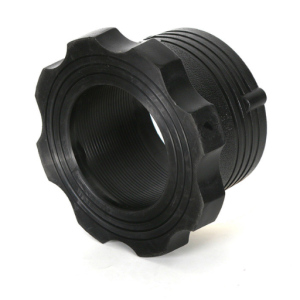
In the market for electrofusion fittings, these have been picked to be used as benchmarks representing their properties and performance. The main competitors in this sector are Victaulic’s fusion coupling fittings, which are reputed for their robust construction and reliable sealing mechanism; Eisele’s high-performing fusion adapters that were made with precise engineering knowledge; and Georg Fischer’s fusion systems, which are compatible with a wide range of applications. It is also noteworthy that Parker manufactures electrofusion fittings known for their ground-breaking design concepts and ease of installation. These products have been assessed based on quality, durability, user-friendliness, customer feedback, and more to give an extensive overview of the best available options in the global market.
Comparing Electrofusion Stub Ends
When assessing electrofusion stub ends, the analysis is based on features such as material compatibility, pressure rating, and ease of installation. Victaulic’s stub ends have been identified by industry analysts who assert that they are durable enough for severe environmental conditions and ideal for high-pressure applications. In addition to the innovation and versatility exhibited by its product range, Georg Fischer can easily be incorporated into different systems. On the other hand, Eisele’s electrofusion stub ends are famous for being carefully manufactured to provide consistent connections that do not leak. This consensus compares all brands, suggesting that selection is contingent upon specific project requirements and operating conditions, although each delivers quality items.
Evaluating Various Types of HDPE Flange Adaptors
When examining HDPE flange adaptors, it’s essential to consider their alignment with existing systems, the material quality, and the installation method. According to prominent sources in the industry, Victaulic’s HDPE flange adaptors are commonly recommended because of their robust construction and resistance to aggressive environmental conditions necessary for many industrial applications. Moreover, Georg Fischer delivers adapters that have an innovative design, making them perfect for both low- and high-pressure systems with a tight fit and reliable performance. Finally, Parker Company has a range of products with easy-to-install features appreciated by customers’ flexibility in accommodating different piping configurations. In conclusion, the choice of flange adaptor should be based on specific project requirements to ensure efficiency and long-term performance.
Critical Differences Between Electrofusion Flanges and Compression Fittings
Electrofusion flanges and compression fittings serve distinct purposes in the HDPE piping industry and offer unique advantages. Electrofusion flanges join fittings directly onto pipes using electrical current, thus ensuring permanent joint connection without any leakage, which is notable in high-pressure applications. This approach is widely recommended due to its reliability, even under severe conditions, in reducing the likelihood of joint failure.
On the other hand, compression fittings are designed for easy installation or disassembly; hence, they can be used where maintenance or adjustments are frequently made. These types of fittings work through mechanical force, which presses them onto pipe walls tightly without using special tools or methods. Though not creating permanent bonds like the electrofusion technique, compression fittings offer more flexibility. They are thus suitable for a wide range of scenarios, including residential settings or those requiring less demanding approaches.
Generally speaking, selecting electrofusion flanges and compression fittings often depends on factors such as operational pressure level, maintenance frequency, and environmental conditions at installation sites.
What are the Differences Between an Electrofusion Flange and a Tee?
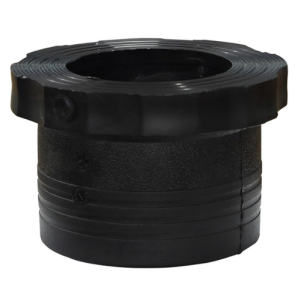
In HDPE piping systems, electrofusion flanges and tees are essential but perform different functions. Electrofusion flanges act as points of connection that allow for the joining of pipes or attachment of other fittings through a secure, welded joint. They are significant in cases where a strong permanent bond is required, like in high-pressure systems.
On the other hand, a tee fitting creates a branch in the pipeline. This enables flow redirection to secondary lines, thereby facilitating fluid distribution within the system. While also accessible using the electrofusion method, tee fittings’ primary purpose is splitting or combining pipe flows instead of being joined by other fittings. Therefore, it’s crucial to understand these differences when choosing fittings for specific needs in HDPE pipeline installations.
Understanding the Use of Electrofusion Flanges
For various conditions, while joining pipes together under different conditions, electrofusion flanges play an essential role within HDPE piping systems. These work by having conductive wires embedded within their edges, which melt over the surface of both pipes and fit when electrically heated, creating a homogenous solid bond between them. This technique guarantees minimal leakage and improved structural stability, especially in high-pressure applications. Additionally, with electrofusion flanges, there is no need for extra joints or couplings, thus improving installation time and reducing areas where problems could occur over time. Their use is particularly advantageous in places where traditional welding is impossible or maintaining connection integrity is critical, such as gas and water distribution networks.
When to Use a Tee in HDPE Pipe Systems
For HDPE pipe systems, a tee fitting is necessary when branching off a main line supplying more than one region or merging flows is necessary. These are commonly used for irrigation systems, where water must be distributed to different areas, and for plumbing, where water must be sent to other outlets. They are instrumental in cases where flow needs to be balanced since they can maintain uniform pressure throughout the network. Besides that, choosing the right size and angle of the tee is essential to minimize turbulence and pressure loss, thus ensuring efficient fluid movement in the system. Always consider your system’s specific design and flow requirements when including tees.
Advantages of Electrofusion Flanges over Tees
Electrofusion flanges have several advantages over traditional tee fittings in HDPE pipe systems. Firstly, these fittings integrate seamlessly, enhancing joint integrity and reducing possible leaks with mechanical fittings. Secondly, electrofusion flanges make installation easier by not needing more fittings and joints, thus making it more straightforward, saving time, and cost-effective. Furthermore, they exhibit excellent resistance against environmental stresses causing joint failure, which is suitable for high-pressure or corrosive situations, unlike tees that introduce many failure points requiring careful flow calculations just for balance and economy within a system. Therefore, applications requiring reliability and performance often prefer electrofusion technology over conventional fittings.
Reference sources
-
HDPE ElectroFusion Fittings Installation Instructions – Plasson USA
This video provides detailed instructions for Plasson USA’s electrofusion HDPE fittings, ensuring reliable and proper installation.
Read more -
Electrofusion Fittings – Total Pipeline Systems
This brochure details the design, applications, and installation procedures for electrofusion fittings, including flanges, for various polyethylene pipelines.
Read more -
Electrofusion Installation Procedure Manual – HDPE.ca
This manual provides comprehensive guidelines on installing electrofusion fittings, including flanges, ensuring proper techniques and best practices.
Read more
Related Articles:Uses of Electrofusion Flange



